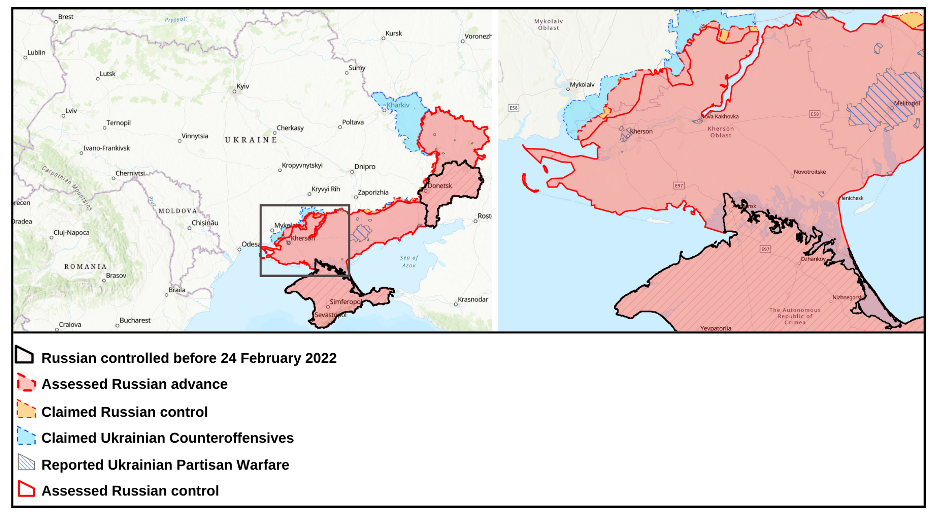Introducing the ‘Life under Occupation’ series
Kherson was the first major Ukrainian city to face Russian occupation in late February 2022. Now, it is a test case for the Kremlin’s forced assimilation of Ukrainian cities into Russia.[1]
This report is the first in a series of open-source investigations by the Centre for Information Resilience’s Eyes on Russia Project, into the Russian occupation of the Kherson region (Ukrainian: Херсонська область). It provides a detailed analysis of life there and more broadly in Ukrainian territories under Russian occupation.
This report sheds light on the mechanisms of occupation: the means used to establish and strengthen Russian occupational rule over seized Ukrainian territories and to force locals to engage with the occupying authorities.
PART ONE: THE MECHANISMS OF OCCUPATION
By Elise Thomas, Belén Carrasco Rodríguez and Alona Shestopalova
Soldiers invade, but it’s bureaucrats who occupy—that’s the reality currently playing out in the occupied parts of the Kherson region,[1] where the Russian invasion has been followed by a second assault by bureaucrats, bankers, commercial interests and law enforcement. Together, these actors are attempting to force the idea of a ‘Russian Kherson’ into reality by making it increasingly difficult for the remaining civilians to survive without participating in the occupation.
As one of the largest population centres under Russian control in 2022, Kherson provides valuable insight into how Russia may attempt to solidify its control in other occupied Ukrainian territories.
The Kremlin—and its arm in Kherson, the occupying authorities—are attempting to entice, persuade, compel, or if need be, violently force civilians in Kherson to accept Russian rule. To access basic needs such as money, transportation, communications and electricity, residents are compelled to acquire Russian citizenship, passports and bank accounts. In the meantime, the Ukrainian government is discussing criminalising[2] the process of obtaining a Russian passport. The necessities of daily life have become a political tool that Russia wields to compel civilians to participate in, and thus strengthen, its occupation of Kherson.
The people of the Kherson region are in a difficult and dangerous position. For some, leaving is not an option. They may be too old, too young, too unwell, or may support relatives who are unable to leave. They also may simply not be able to afford it. Social media posts advertising transport out of the occupied regions quote prices ranging from around 7,000 Ukrainian hryvnia (UAH) and up per person (around £165). These costs are substantially more for people with mobility issues or special needs.
Those who are unable to leave face a choice between cooperating with the Russian occupiers and their local collaborators or attempting to survive without access to the basic necessities of life – a difficult, if not impossible, prospect with the freezing Ukrainian winter looming.
Furthermore, Russia is attempting to capture not only territory, but the minds of Kherson’s young people. As the new school year began on 1 September, children in the region have entered an entirely new reality, in which education in Russian language and according to Russian propaganda.[3]
This is as much a psychological occupation as a physical one. The occupying authorities have been clear about their goal of creating a feeling amongst the locals that there is no alternative to Russia. They consistently speak about integration as an inevitable and natural process of ‘returning’ Kherson to Russia.
They have also launched an astroturfed pro-Russian movement (an online campaign that poses as a local grassroots movement, but in reality is funded and directed by the Russians)[4] and the propaganda campaign ‘We Are Together with Russia’ (“Мы вместе с Россией!”) which has held rallies and forums across Kherson and in other newly occupied Ukrainian territories, such as parts of the Zaporizhzhia region.[5]
The threat of physical violence remains pervasive. Armed Russian soldiers patrol administrative offices, and social media is full of posts from desperate relatives looking for family members who have been taken from their homes by Russian forces.
In Kherson, Russia exercises power through both the soldier’s gun and the bureaucrat’s pen. This report provides a snapshot of the mechanisms that Russian authorities and collaborators use to compel residents of the region to collaborate with the occupation regime. It explains the mechanisms utilised by the occupying authorities to consolidate power in the region, such as propaganda and the use of law enforcement and violence to encourage assimilation. It also details the policies and mechanisms directly impacting the day-to-day lives of civilians residing in the region, including their access to pensions, utilities, transport, essential services, and education.
With a “referendum” to further consolidate Russian power in Kherson and officially assimilate the territory in the Kremlin’s eyes, it is critical these coercive methods are exposed, as no vote taking place under such circumstances can be legitimate. The future of Kherson—and other occupied regions of Ukraine—hangs in the balance.
Notes
While some key figures of Russian occupying administration in Kherson are mentioned in this report, this report does not provide extensive background or information about them because this will be the focus of the second report in this series. Transliteration is provided where relevant.
This investigation analyses data from 1 March to 10 September 2022 through a combination of open-source techniques. Evidence gathered includes pictures, videos, news articles, and social media posts collected from the occupying authorities in Kherson, official Kremlin media, pro-Kremlin websites, international media, Ukrainian media, Telegram, Twitter, and TikTok accounts, etc.

Figure 1: Map of the occupation of the Kherson region as of 19 September 2022. Courtesy: Institute for the Study of War and American Enterprise Institute’s Critical Threats Project.[7]
[1] Thomas (17 June 2022). Available at: https://www.info-res.org/post/briefing-how-russia-is-consolidating-power-in-kherson
[2] Ukrinform (28 July 2022). Available at: https://www.ukrinform.ua/rubric-ato/3538409-kontrnastup-zsu-na-hersonsini-nabirae-obertiv-britanska-rozvidka.html
[3] Reuters (5 September 2022). Available at: https://www.reuters.com/world/europe/kherson-referendum-plans-paused-due-security-situation-tass-cites-russian-2022-09-05/
[4]На самом деле в Херсоне (7 September 2022). Available at: https://t.me/NSDVCH/7289
[5]Tass (5 September 2022). Available at: https://tass.com/politics/1502703
[6] Администрации Херсонской области (20 September 2022). Available at: https://t.me/herson_rus/5433
[7] Institute for the Study of War and American Enterprise Institute’s Critical Threats Project. Last accessed 19 September 2022. Available at: https://storymaps.arcgis.com/stories/36a7f6a6f5a9448496de641cf64bd375
